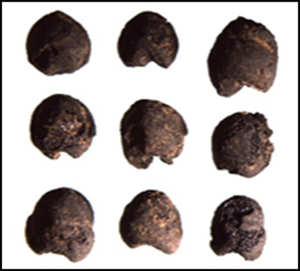ワシントン大学セントルイス校の研究によると、約4000年前の中国北部では、西南アジアから伝わった新しい穀物を栽培するために、意図的に水を管理する灌漑という方法が採用されていたことがわかった。 Research from Washington University in St. Louis shows that a practice of purposeful water management, or irrigation, was adopted in northern China about 4,000 years ago as part of an effort to grow new grains that had been introduced from southwest Asia.
2022-11-09 ワシントン大学セントルイス
本研究では、中国の黄土高原で発掘された50以上の遺跡から、小麦、大麦、キビなどの穀物植物の炭化した種子遺骸35,000個以上を8千年以上の時間枠で同定しました。このコレクションから選ばれた植物遺体は、放射性炭素年代測定と同位体比測定が行われました。
その結果、小麦と大麦の間に大きな違いがあることがわかりました。
小麦は、地元の泉の近くや保水力の高い土壌など、水を最も利用できる場所に戦略的に植えられていた可能性があるのだ。
大麦は、黄土高原の乾燥した丘陵地帯で、特別な水管理をすることなく栽培されていたようだ。
このことから、古代の農民がこの2つの作物の異なる水需要を利用することで、土地利用と作物収量を最適化しようとしたことを示唆している。
<関連情報>
- https://source.wustl.edu/2022/11/thirsty-wheat-needed-new-water-management-strategy-in-ancient-china/
- https://www.cambridge.org/core/journals/antiquity/article/water-and-soil-management-strategies-and-the-introduction-of-wheat-and-barley-to-northern-china-an-isotopic-analysis-of-cultivation-on-the-loess-plateau/3FC2D49A7CEDF5EFB464D44E9C581A28
中国北部への小麦・大麦の導入:黄土高原における栽培の同位体分析 introduction of wheat and barley to northern China: an isotopic analysis of cultivation on the Loess Plateau
Haiming Li,Yufeng Sun,Ying Yang,Yifu Cui,Lele Ren,Hu Li,Guoke Chen,Petra Vaiglova,Guanghui Dong and Xinyi Liu
Antiquity Published:09 November 2022
DOI:DOI: https://doi.org/10.15184/aqy.2022.138

Abstract
Studies of ‘food globalisation’ have traced the dispersal of cereals across prehistoric Eurasia. The degree to which these crops were accompanied by knowledge of soil and water preparation is less well known, however. The authors use stable isotope and archaeobotanical analyses to trace long-term trends in cultivation practices on the Loess Plateau (6000 BC–AD 1900). The results indicate that ancient farmers cultivated grains originating in South-west Asia and used distinct strategies for different species. Barley was integrated into pre-existing practices, while wheat was grown using novel soil and water management strategies. These distinct approaches suggest that the spread of prehistoric crops and knowledge about them varied by local context.



